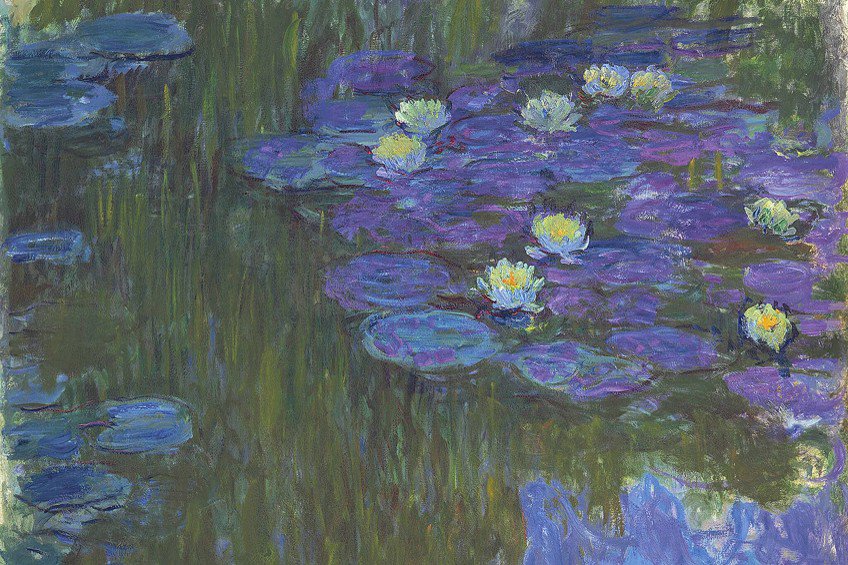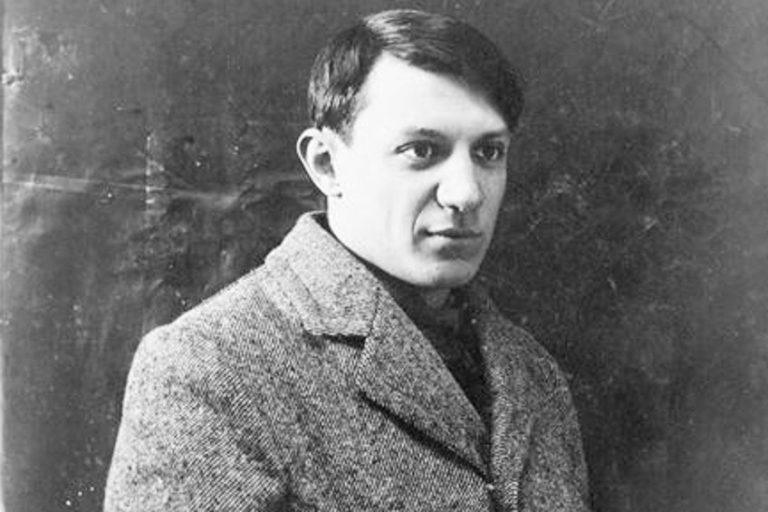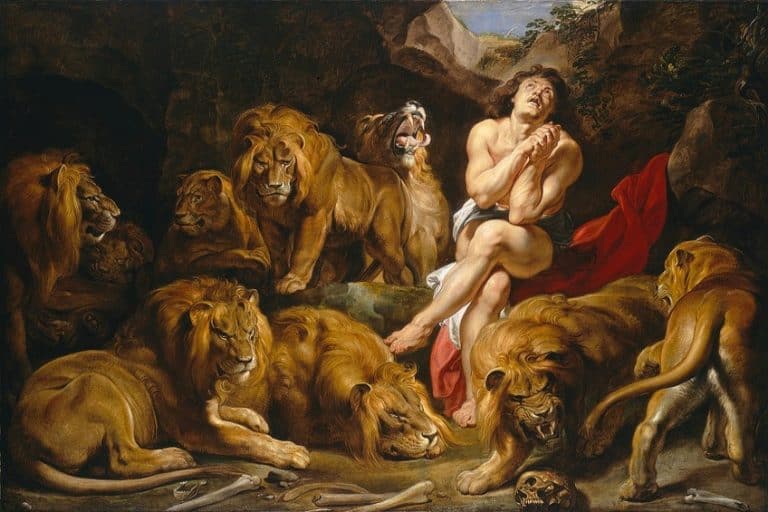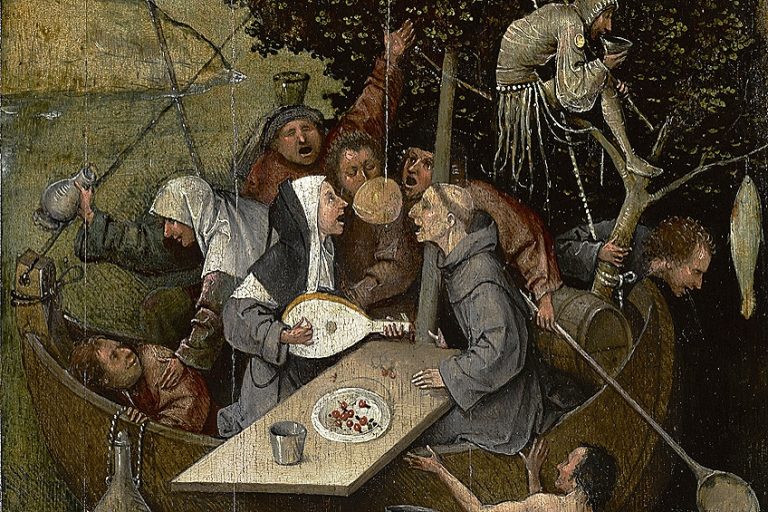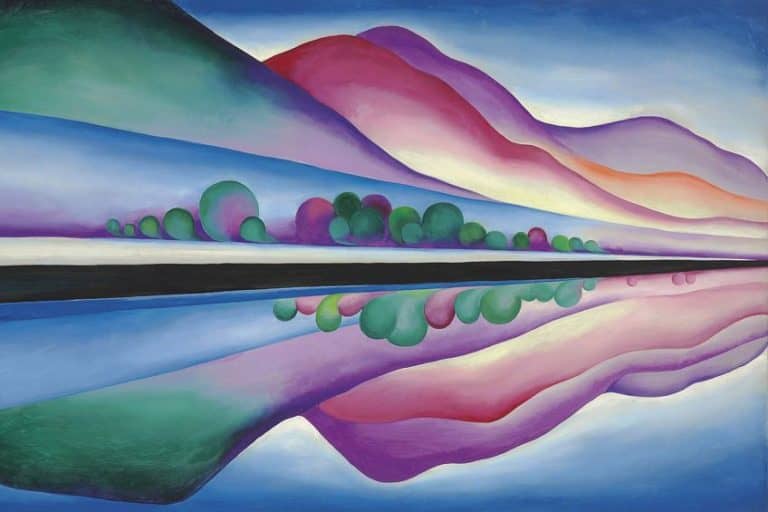Claude Monet Paintings – A Look at 15 of Monet’s Greatest Works
Many art lovers instantly recognize the style and contributions of Claude Monet, but seldom understand the true depth and history behind his production process and some of his masterworks. What is Claude Monet’s most famous painting, what is the most expensive Monet painting, and what makes a Monet artwork Monet? These are just a few burning questions we will discuss in this article about the best works of French Impressionist painter, Claude Monet. Read on to discover some of the French artist’s most celebrated works in art history!
Master of Impressionism: Claude Monet
Claude Monet is a name that is synonymous with the groundbreaking Modern art movement known as French Impressionism. But who was this innovative painter, and why are his works so valuable today? Born as Oscar-Claude Monet in 1840, Monet’s passion for color and observation was beautifully manifested in his Impressionist paintings that were born out of his experimentation with light and recognition of nuances in color as the seasons changed.
Later in his career, Monet’s works were affected by his weakening eye strength and the quality of his vision resulted in many interesting and fuzzy-looking paintings that are valued at millions of dollars.
In his career, Monet was acquainted with many French painters who strove to find new techniques and styles in painting and had grown tired of the academic rules imposed on painters to “achieve success” at major destinations like the Salon. Along with figures like Alfred Sisley and Auguste Renoir, Monet rejected traditional approaches to landscape painting and mastered the outdoor painting technique known as en plein air, which was taught by Eugéne Boudin.
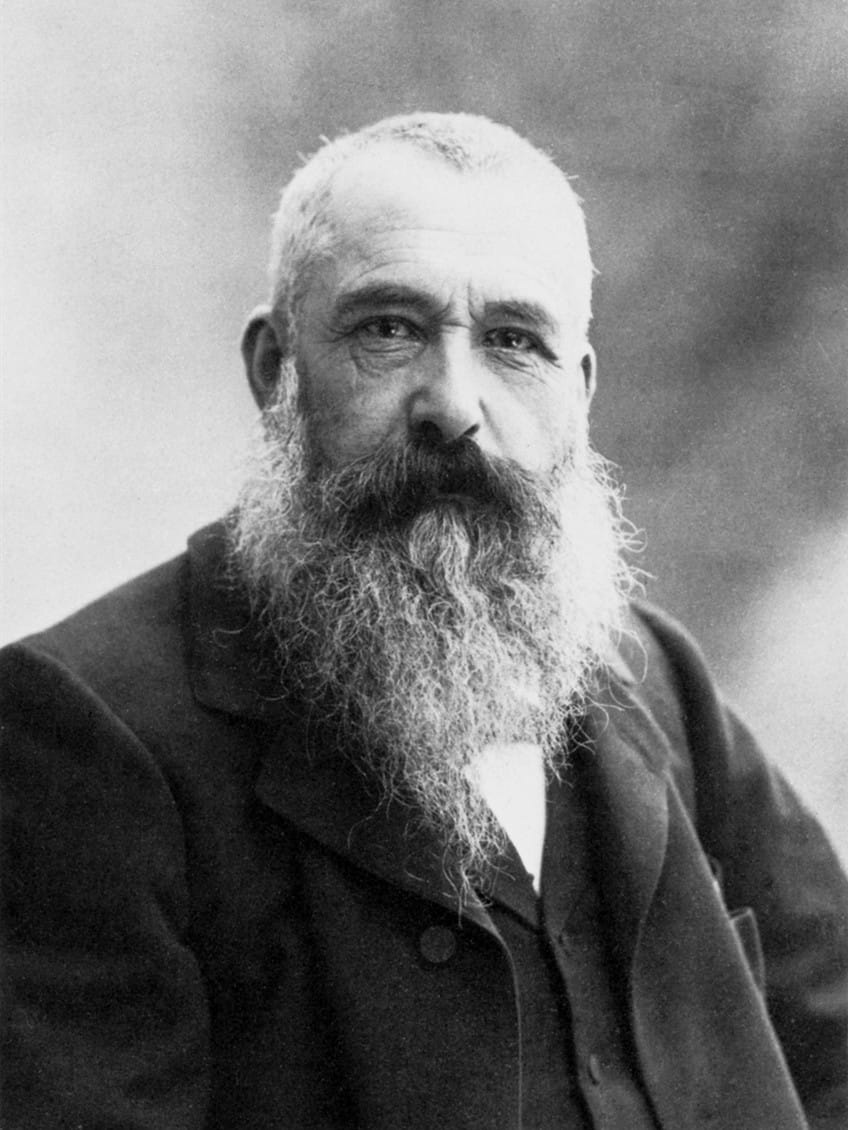
In his early years, Monet’s career began as simple sketches from which he developed his passion for nature and landscapes. From a young age, Monet pursued art in his hometown at Le Havre and moved to Paris in 1859 to complete his art training at the Académie Suisse and later at the esteemed École des Beaux-Arts. It was early in his career that his art style began to diverge from the academic approaches that were ingrained in many painters at the time.
Around the mid-1860s, Monet became a member of a collective in the Forest of Fontainebleau, which was known as the Barbizon School, where he was exposed to works from artists such as Jean-Baptiste-Camille Corot and Camille Corot.
The Barbizon school style of painting stood out since many of the painters painted directly from life. Monet’s experience at the Barbizon School is what prepared his artistic career to take a more focused direction and which saw him employ more meticulous observations in his depiction of color, form, and light. Throughout his career, the French Impressionist engaged in rigorous experimentation with his subjects and techniques, which were best captured in a series that featured poplar trees, haystacks, and landscapes where he spent time with his family and acquaintances.
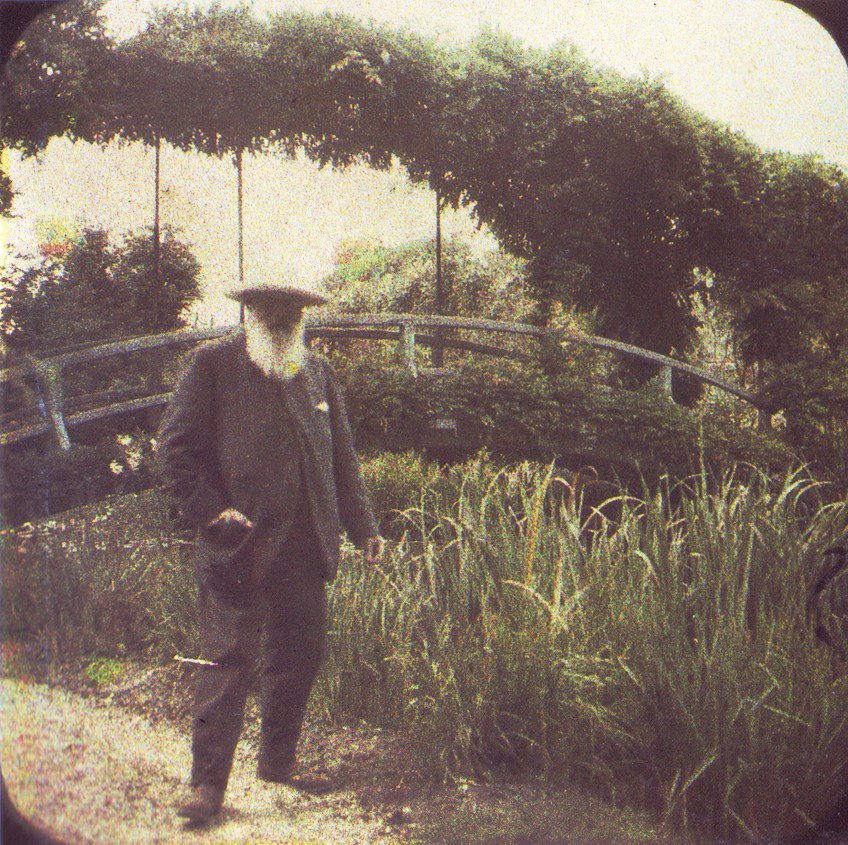
The development of Monet’s subjects also worked in conjunction with the development of his painting style, which saw shifts in his use of atmospheric effects. In terms of Monet’s painting techniques, his masterful use of light and color was highlighted in his paintings such as his depiction of his garden at Giverny under varying conditions. Such works revealed the artist’s obsession with changes in light, weather conditions, and reflections on watery surfaces.
His work was further characterized by loose brushwork and broken, disjointed portions of color, which soon came to define the movement of Impressionism itself and highlighted the way that light interacted with Monet’s subjects.
As an avid traveler, Monet ventured on many journeys and encountered various natural destinations in France and abroad to provide him with visual inspiration, which led to the creation of his best work. Regardless of the initial resistance to the artist’s work from various establishments, Monet’s paintings began to receive acclaim from international collectors and have since left an irreplaceable mark on the art world. Towards the end of the 19th century, Monet was already recognized as a master artist and leader of French Impressionism.
The Value of Monet’s Paintings
So how did French Impressionism gain traction? The art style of French Impressionism was determined by en plein air painting, which was characterized in Monet’s work as short brush strokes, strong colors, and a focus on form and shape as opposed to objects and detailed scenes. The French Impressionists gathered to exhibit their work around 1874, which garnered attention from critics who thought the works to be incomplete and distasteful.

Over time, Monet’s influence grew along with his legacy, which left a profound impact on the way people viewed art and is thought to have been the path for early forms of abstracting shape and form and opting for demonstrating the beauty in the nuances of color, which miss (and catch) our eyes every day.
Today, Monet’s works are valued at over $110 million, which certainly surpasses the artist’s early artist fee of only 20 francs!
What Makes and Sells a Monet?
What makes a Monet artwork so Monet? The many famous Monet paintings are considered famous for the artist’s characteristic Impressionist painting style. There were many Impressionists who created works that explored the effects of light on color variations, however, there is no artist whose works are said to be way too similar to a “Monet” painting. Among the unique aspects of his portfolio is his distinct color palette that traverses through carefully curated landscape scenes that highlight the pastel, blurry, and gradated viewpoints that Monet admired.
Monet’s style was best realized in the output of his works, most notably in his water lily series, which drew out his observations of varying shades of blue, purple, pink, orange, and green in different arrangements across 250 paintings.
His rendition and understanding of natural surfaces, colors, and seasonal variations of light and its effects were phenomenal. Furthermore, what made Monet as an artist stand out was that he did not simply paint what he saw, instead, he painted versions of what he created. He was known to create and cultivate his own garden in Giverny while remodeling the landscape to his desired reality, such that he could create a peaceful environment for introspection and painting.

Of interesting note is that his water lilies also defied the city council regulations since he had them imported from South America and Egypt, which makes his paintings incredibly unique in their context and existence. Despite this, Monet’s last works were only rediscovered in the 1950s after curators credited him as being a pioneer of modern art and saw the Museum of Modern Art acquire their first Monet painting in 1955. Before this, Monet had also been known to destroy his own works when he was dissatisfied with the result.
From his water lily series in particular, he destroyed around 15 paintings in 1908, thus making him a perfectionist in his mature era.
Monet vs. Environmental Activism
In 2022, Monet’s most expensive painting, Meules (1890) was the subject of news headlines across the globe as it was the target of the Letzte Generation environmental activist group, who hauled mashed potatoes at the artwork and glued their bodies to the wall. Thankfully, the painting was shielded by a glass barrier that protected the work from damage. While many appreciate the work of great painting masters such as Monet, the art world and its major patrons and institutions are continuously the subject of criticism for the copious amounts of money that flow through the art market and put into question the priorities of the art world and its supporters when faced with the urgent global environmental crisis.
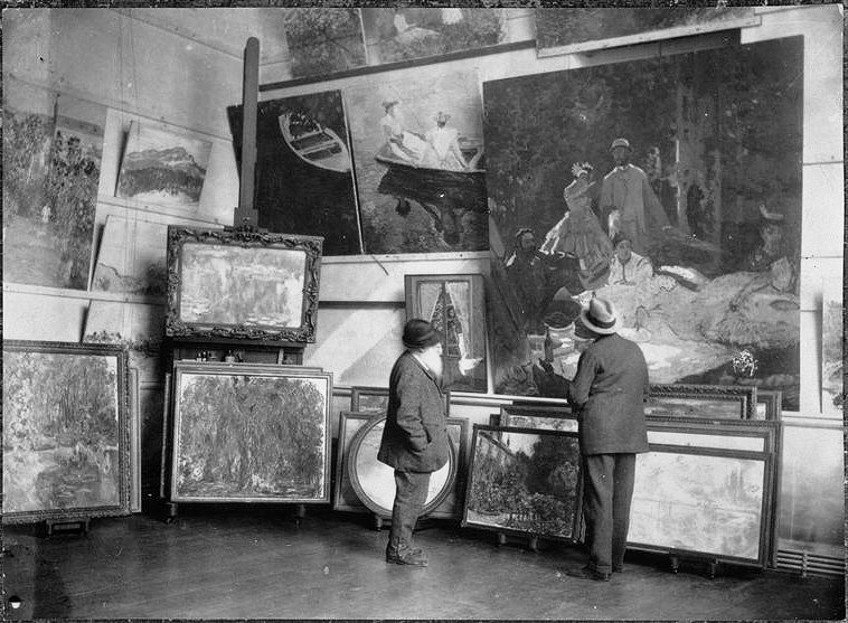
At the same time, many groups have resorted to such acts to garner attention to causes that are deemed more important than reminiscing on the works of art, which hold immense commercial value, yet are not as significant in the broader scheme of environmental concerns. As it stands, historical artistic figures and their works, such as those of Monet, still need to be protected, even if unsold, and are allowed to be appreciated by all who admire the painting styles of the French artist.
However, it is still a matter of critical debate as to the importance and relevance of Monet’s works, and other historical figures, in contemporary society. It is also of keen interest to question the priorities of those who choose to focus on past achievements versus the realities of society that affect every person on the planet.
15 Famous Claude Monet Paintings You Should Know
What are three famous paintings by Monet? Now that you have an idea of the value of Monet and his role in defining one of the 19th century’s most revolutionary art movements, we can explore, not just three, but the top 15 most famous Monet paintings that have captivated art lovers far and wide!
The Beach at Sainte-Adresse (1867)
| Date | 1867 |
| Medium | Oil on canvas |
| Dimensions (cm) | 75.8 x 102.5 |
| Where It Is Housed | The Art Institute of Chicago, Illinois, United States |
Among the best Claude Monet paintings are his pastoral works that showcase the beauty of nature in the summer. Monet created this famous landscape painting in 1867 titled The Beach at Sainte-Adresse, which he painted during his stay with his aunt in the wealthy suburbs of Sainte-Adresse.
It is thought that Monet started the piece during an overcast day and revised the scene later in his studio, while referring to works from his other canvases.

According to an in-depth analysis of the work, Monet initially intended for it to represent a yacht scene with tourists on the beach, however, the final piece was transformed into a picturesque view of the local fishermen and their sailboats. Along with the works of his avant-garde contemporaries, Monet exhibited The Beach at Sainte-Adresse at the second Impressionist show in 1876.
La Grenouillère (1869)
| Date | 1869 |
| Medium | Oil on canvas |
| Dimensions (cm) | 74.6 x 99.7 |
| Where It Is Housed | The Metropolitan Museum of Art, New York City, United States |
Painted in 1869, this lovely summer painting by Monet was created alongside Auguste Renoir, who painted a similar scene. The two artists set up their easels along the Seine River near a local bathing and boating resort, of which Monet recalled that he had a dream where he made a few bad sketches of the baths of La Grenouillère.
In fulfillment of his dream, Monet took to the Seine with Renoir to capture the serene and inviting cool blues of the river and its reflections from a shady position.
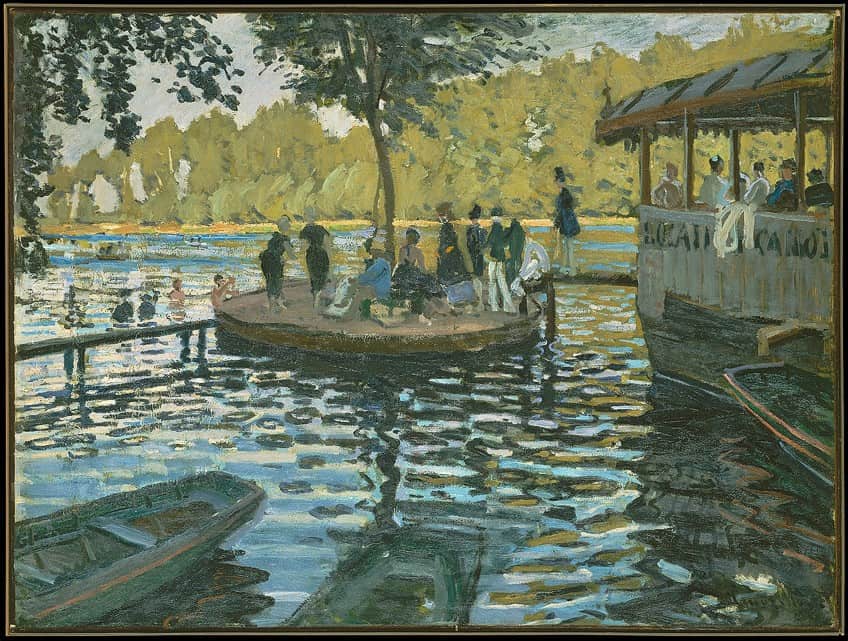
Impression, Sunrise (1872)
| Date | 1872 |
| Medium | Oil on canvas |
| Dimensions (cm) | 48 x 63 |
| Where It Is Housed | Musée Marmottan Monet, Paris, France |
This is the painting that started it all. Impression, Sunrise is the first Impressionist painting by Monet that was created in 1872, just two years before the first Impressionist show in 1874. The serene atmospheric effect in the painting was inspired by a scene at Le Havre, which was the hometown of Claude Monet. The simple composition draws in viewers’ attention by the burning glow of the orange sun depicted at the dawn of the day.
Monet completed a few other works of the same scene while painting from a hotel near the port. In 1985, the famous Monet painting was stolen from the Musée Marmottan Monet in Paris and later recovered in 1990.
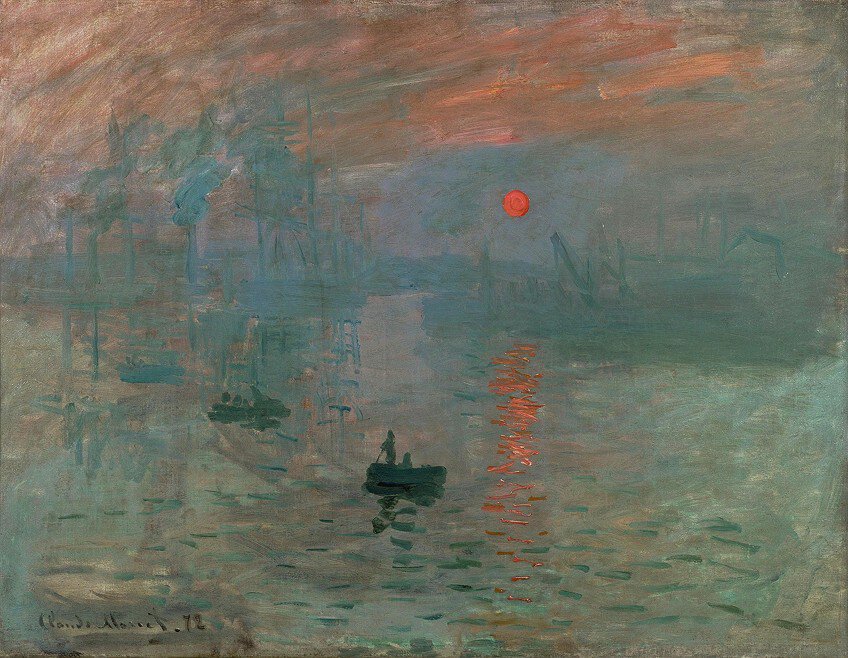
Poppy Field (1873)
| Date | 1873 |
| Medium | Oil on canvas |
| Dimensions (cm) | 65 x 50 |
| Where It Is Housed | Musée d’Orsay, Paris, France |
Poppy Field is one of the most famous Claude Monet paintings that was created in 1873 and captured the bright landscape of the poppy field near Argenteuil, which was the artist’s home after he returned from England. The painting is said to be one of Monet’s first paintings that demonstrates his tendency toward abstraction as seen in the splotches of red across the canvas to depict, in a simple way, the red poppies.
He also outlined two different color zones seen in the colors of the red poppies contrasted by the bluish-green field as his wife and small son stroll casually in the field.

Woman with a Parasol – Madame Monet and Her Son (1875)
| Date | 1875 |
| Medium | Oil on canvas |
| Dimensions (cm) | 100 x 81 |
| Where It Is Housed | National Gallery of Art, Washington, D.C., United States |
Woman with a Parasol – Madame Monet and Her Son captures a view of Monet’s wife Camille and their son, who are portrayed in a vibrant arrangement of animated brush strokes that highlight the brilliance of the sunlight shining behind the figures. This gentle scene exposes Monet’s inner life and family relationships as his wife and son were often featured in his outdoor landscapes.
The features of his models were also delineated along with the rest of the composition to create a more harmonious painting and capture a dear memory.

Meules (1890)
| Date | 1890 |
| Medium | Oil on canvas |
| Dimensions (cm) | 72.7 x 92.6 |
| Where It Is Housed | Museum Barberini, Potsdam, Germany |
Showcasing the transience of light, this $110.7 million painting by Monet is regarded as one of his most famous works that was painted between 1890 and 1891 and was part of the artist’s haystack series from Giverny. The painting sold at Sotheby’s in New York in 2019 for the large sum of $97 million, including sale fees, amounted to the final price of $110.7 million. A precursor to the Haystack series can be spotted at the Pushkin Museum in an 1884 painting titled Haystack with other large collections of the series housed at the Musée Marmottan Monet and the Musée d’Orsay.
Monet’s representation of atmospheric effects was focused on color harmony within specific selections of subjects.
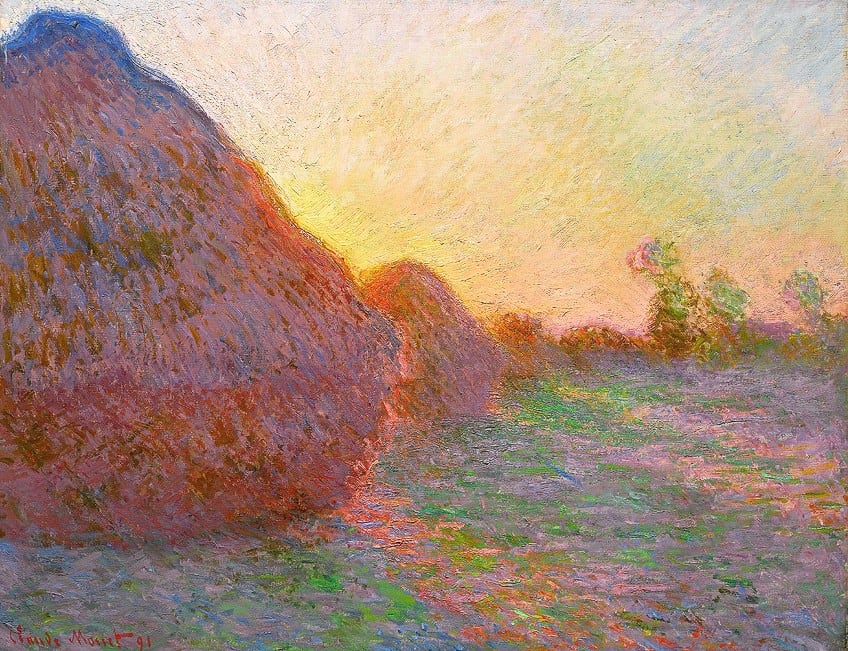
His rich use of color and wisdom in portraying the hay stacks was seen as simple and unimaginative, however, most would note that Monet’s work, despite the simple subjects, was always carefully chosen. Monet’s study of the haystacks was meticulous as he drew attention to the direct light that hit the hay and re-analyzed them from different viewpoints ranging from atmospheric conditions to muted effects. Initially, this painting’s value was estimated to be $55 million but shocked many as his eager patrons were more than willing to pay double, thus making it the first Impressionist painting to exceed $100 million.
The Four Trees (1891)
| Date | 1891 |
| Medium | Oil on canvas |
| Dimensions (cm) | 81.9 x 81.6 |
| Where It Is Housed | The Metropolitan Museum of Art, New York City, United States |
In the summer of 1891, Claude Monet created this famous series of Poplar trees lined up along the Epte River in Giverny. The series was captured in Monet’s signature Impressionist style, however, stands out for its distinct palette of soft lilac and pastel yellow hues that make the painting particularly romantic.
Monet managed to complete his series only after he paid a lumber merchant to prevent the trees from being uprooted, only until he finished his work.
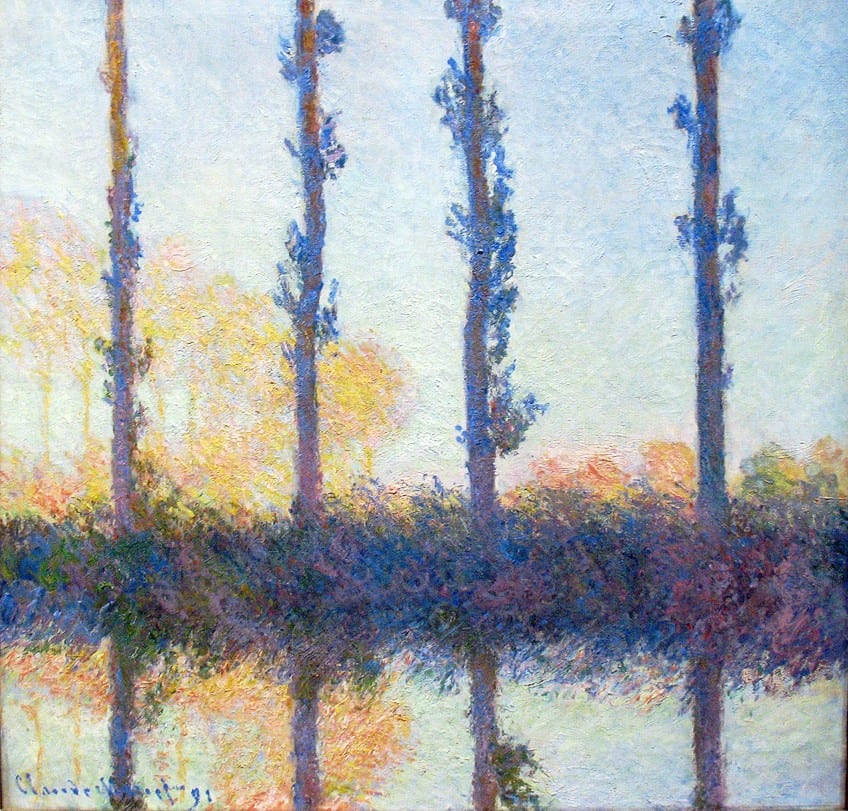
The series thus captured a tragic moment when Monet was the only one standing between the longevity and survival of the poplars. 15 of the works were exhibited in 1892 in Paris, alongside his haystack series. At the end of his painting project, Monet resold the poplars back to the lumber, who had a use for the trees.
Meule (1891)
| Date | 1891 |
| Medium | Oil on canvas |
| Dimensions (cm) | 72.7 x 92.1 |
| Where It Is Housed | Private collection |
Meule is among the most famous Claude Monet paintings that was featured as part of his grain stack series. The series is considered to be one of money’s most adventurous collections that captures the atmospheric landscape of a haystack field. The series was also regarded as perhaps one of the most challenging considering that Monet was 50 years old at the time and was painted in such a way that the scene appears to be a vivid memory, as though one is experiencing the landscape while sitting with Monet.
Throughout the late 1880s, Monet had been known to experiment with various single landscape scenes and portray different weather conditions, however, he did not imagine that he would be painting large collections, that were more than 25 canvases in total, to depict his exploration of atmospheric effects, color, and touch.

The sites for Monet’s inspiration were only a few steps out of his home in Giverny, as the artist was almost always drawn to the rural landscapes, from the fields to the far hills close to the bank of the Seine River. Monet’s grain stack series follows the narrative where local farmers used to pile hundreds of sheaves of wheat stalks into tightly condensed conical bundles that represented the fruits of the labor of local farmers and hope for the future. In 2016, this painting from Monet’s grain stack series titled Meule sold for a whopping $81.4 million at Christie’s in New York.
Rouen Cathedral (1894)
| Date | 1894 |
| Medium | Oil on canvas |
| Dimensions (cm) | 107 x 73.5 |
| Where It Is Housed | Musée d’Orsay, Paris, France |
Monet’s Rouen Cathedral series encompasses over 30 paintings that the artist created between 1892 and 1893 while based in Normandy, all of which he reworked in 1894. Monet set up his studio across the cathedral and only selected 20 out of the lot to exhibit at an art gallery in Paris. Approximately eight works from the show had sold with the series receiving praise from Monet’s contemporaries, including Camille Pissarro.
What made the painting particularly impactful was the time at which it was produced in the early 1890s, which saw a complete revival of Catholicism in France.

The religious significance of the painting has also been contrasted with the architectural style of the Rouen Cathedral, which was constructed in the Gothic style and became an iconic symbol of French culture and history that was adopted throughout the Middle Ages.
Bridge Over a Pond of Water Lilies (1899)
| Date | 1899 |
| Medium | Oil on canvas |
| Dimensions (cm) | 92.7 x 73.7 |
| Where It Is Housed | Metropolitan Museum of Art, New York City, United States |
Bridge Over a Pond of Water Lilies is by far one of the most famous Monet paintings to date, which can be spotted at the Metropolitan Museum of Art in New York. Just under a meter in length, the stunning painting was created in 1899 and inspired by Monet’s passion for horticulture, which can be seen in his many studies of the pond at his home in Giverny.
Monet constructed his own source of inspiration that was motivated by the pleasures of the eye, which at the same time would become one of his best-known works from the turn of the century.
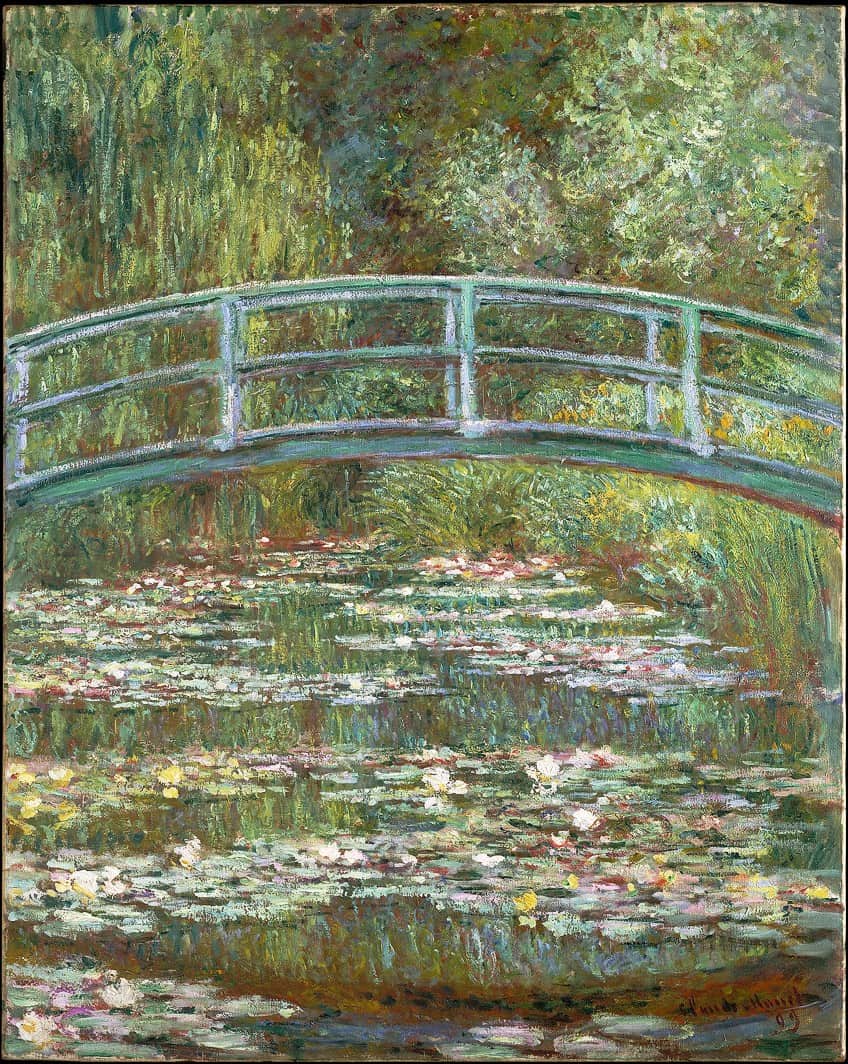
The water-lily garden inspired him to produce numerous paintings that captured the greenery of the land, as well as the many gorgeous natural reflections from the sunlight and bridge. What makes this particular painting stand out is its vertical orientation, which was an unusual decision for Monet in this series.
Waterloo Bridge, Soleil Voilé (1899 – 1903)
| Date | 1899 – 1903 |
| Medium | Oil on canvas |
| Dimensions (cm) | 65.4 x 100 |
| Where It Is Housed | Private collection |
Waterloo Bridge, Soleil Voilé captures one of the sources of Monet’s inspiration from his trip to London, which began on the 15th of September in 1899. Monet was accompanied by his wife and stepdaughter, all of whom were on a trip to visit Monet’s son Michel in London. While Monet was keen on visiting his son and letting his family enjoy their sightseeing trip, he had other plans to create a new series of works that were inspired by the city.
As such, the family ended up at the Savoy Hotel, which was situated perfectly between Waterloo Bridge and Charing Cross Bridge, thus giving Monet a spectacular visual experience from the sixth floor.

Once Monet spotted the magnificent view from his sixth-floor room, his one-month vacation quickly turned into a six-week painting campaign, and resulted in this magnificent painting capturing a view of the Waterloo Bridge. In 2022, Waterloo Bridge, Soleil Voilé was sold for $64.5 million at Christie’s in New York.
Le Parlement, Soleil Couchant (1900 – 1903)
| Date | 1900 – 1903 |
| Medium | Oil on canvas |
| Dimensions (cm) | 81.2 x 92 |
| Where It Is Housed | Private collection |
Sold at an auction for $75.9 million at Christie’s in New York, this famous Claude Monet painting of the English capital’s monumental landmark was created between 1900 and 1903. Vues de Londres is Monet’s most stunning series of paintings that capture the timeless and magical beauty of the Houses of Parliament and the soft, dramatic, and atmospheric conditions of the fog-filled sunset.
In an almost meteorological color palette, Monet captured the wonderful orange of the setting sun, highlighted by hues of purple, pink, and inky cobalt blues, which created a theatrical effect from his view while staying at the Savoy Hotel and Saint Thomas Hospital.

The Houses of Parliament, Sunset (1903)
| Date | 1903 |
| Medium | Oil on canvas |
| Dimensions (cm) | 81 x 92 |
| Where It Is Housed | National Gallery of Art, Washington, D.C., United States |
In a series that culminated in 19 oil paintings of the parliament building, Monet depicted this famous view of the British Parliament in 1903 while staying in London. Monet created multiple versions of the scene that capture the building’s architecture at different points in the day and night. Monet’s approach to helping viewers understand his art was that it was simply produced for the viewer to criticize the final result.
His “Houses of Parliament” series is known to amount to 19 paintings, of which capture a portion of his 100-painting series at the time.
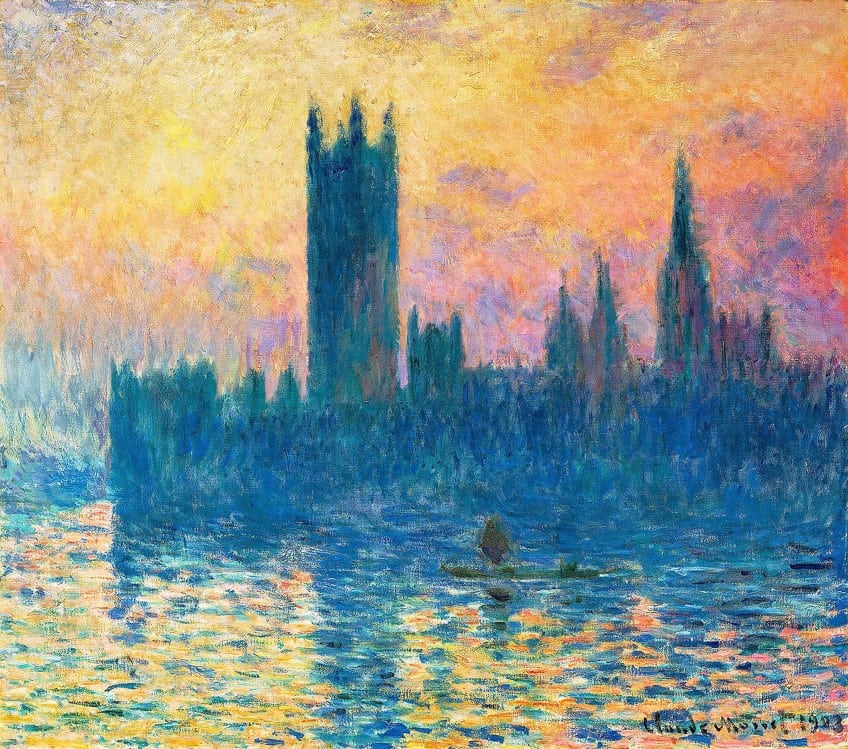
Nymphéas en Fleur (Water Lilies in Bloom) (1914 – 1917)
| Date | 1914 – 1917 |
| Medium | Oil on canvas |
| Dimensions (cm) | 160.02 x 180.02 |
| Where It Is Housed | Rockefeller private collection |
Nymphéas en Fleur sold for $81.7 million in 2018 and currently belongs to the private collection of the Rockefeller family. Yet another famous painting from Monet’s Water Lilies series that beautifully captured the avant-garde scale of painting following the First World War, this magnificent work of art was created between 1914 and 1917.
The work’s title was translated into English to “Water Lilies in Bloom” and was created using a variety of techniques that Monet was experimenting with at the time.

Le Bassin Aux Nymphéas (1919)
| Date | 1919 |
| Medium | Oil on canvas |
| Dimensions (cm) | 100 x 201 |
| Where It Is Housed | Private collection |
Le Bassin Aux Nymphéas is among the most expensive paintings by Monet, which features a scene from his series of water lily paintings. What makes this painting stand out from the rest of his collection is the incredible detail that he used to portray the shadows and the glistening light.
The painting is also regarded as one of the first few in the series to capture the nuances of the light hitting the delicate flowers at different points in the day.
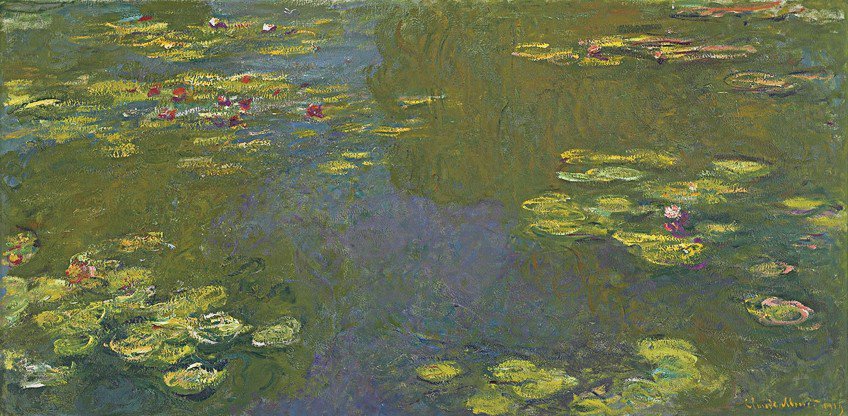
Many of Monet’s Water Lilies paintings have sold for millions of dollars, however, thus famously emphasizing painting. Had sold for around $80.4 million in 2008, thus making it one of the highest paid for and most expensive Monet paintings to date that was sold on auction in London.
Claude Monet’s paintings continue to be appreciated by many as timeless treasures that are admired for their remarkable visual qualities. Monet’s mastery of depicting light, color, and atmosphere were best immortalized in iconic series like “Water Lilies” and “Rouen Cathedral”, which showcases Monet’s ability to capture nature’s fleeting moments onto canvas. Whether it is the play of sunlight on water or the complex nuances of changing seasons, Monet’s paintings evoke an emotional connection with nature that extends beyond time and culture.
Take a look at our Claude Monet artworks webstory here!
Frequently Asked Questions
What Are Three Famous Paintings by Monet?
Three of the most famous paintings by Claude Monet include works from his Water Lilies (1896 – 1926) series, Impression, Sunrise (1872), and Woman with a Parasol – Madame Monet and Her Son (1875).
What Is Claude Monet’s Most Famous Painting?
Impression, Sunrise (1872) is considered to be the most famous Claude Monet painting to date, since this was also his first Impressionist painting that he exhibited to introduce his new style. The painting is recognized as the source from which the term Impressionism was born.
What Is the Most Expensive Claude Monet Painting?
Meules (1890) is recognized as Claude Monet’s most expensive painting, which sold for a massive $110.7 million in 2019. The painting sold at Sotheby’s in New York and has since garnered global attention as the record price paid for a Monet artwork.
Which Famous Monet Painting Was Destroyed by a Fire?
In 1958, a fire broke out at the Museum of Modern Art in New York City, which destroyed an original Claude Monet painting from his Water Lilies series. The painting, Water Lilies (1916), along with four others, was damaged, however, the remains were reconstructed digitally and the burnt painting was donated to the Institute of Fine Arts at New York University.
How Many Paintings Did Monet Destroy?
Claude Monet was known to be his own greatest critic, and was also a perfectionist at heart. It has been estimated that Monet had destroyed 500 of his own artworks around 1908 that would have been exhibited in Paris, however, the exhibition had to be postponed after he attempted to destroy 15 of his Water Lilies paintings.
Jordan Anthony is a film photographer, curator, and arts writer based in Cape Town, South Africa. Anthony schooled in Durban and graduated from the University of the Witwatersrand, Johannesburg, with a Bachelor of Art in Fine Arts. During her studies, she explored additional electives in archaeology and psychology, while focusing on themes such as healing, identity, dreams, and intuitive creation in her Contemporary art practice. She has since worked and collaborated with various professionals in the local art industry, including the KZNSA Gallery in Durban (with Strauss & Co.), Turbine Art Fair (via overheard in the gallery), and the Wits Art Museum.
Anthony’s interests include subjects and themes related to philosophy, memory, and esotericism. Her personal photography archive traces her exploration of film through abstract manipulations of color, portraiture, candid photography, and urban landscapes. Her favorite art movements include Surrealism and Fluxus, as well as art produced by ancient civilizations. Anthony’s earliest encounters with art began in childhood with a book on Salvador Dalí and imagery from old recipe books, medical books, and religious literature. She also enjoys the allure of found objects, brown noise, and constellations.
Learn more about Jordan Anthony and the Art in Context Team.
Cite this Article
Jordan, Anthony, “Claude Monet Paintings – A Look at 15 of Monet’s Greatest Works.” Art in Context. October 10, 2023. URL: https://artincontext.org/claude-monet-paintings/
Anthony, J. (2023, 10 October). Claude Monet Paintings – A Look at 15 of Monet’s Greatest Works. Art in Context. https://artincontext.org/claude-monet-paintings/
Anthony, Jordan. “Claude Monet Paintings – A Look at 15 of Monet’s Greatest Works.” Art in Context, October 10, 2023. https://artincontext.org/claude-monet-paintings/.


